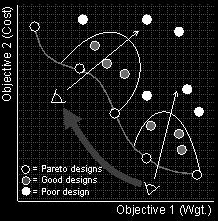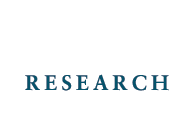| |
|
A-DESIGN - AGENT BASED ADAPTIVE CONCEPTUAL DESIGN
INTRODUCTION | ITERATIVE SEARCH PROCESS | MULTIOBJECT DESIGN SELECTION | MULTI AGENT ARCHITECTURE | FUNCTIONAL REPRESENTATION | A DESIGN AS SEARCH STRATEGY | TEST RESULTS | DISCUSSION AND CONCLUDING REMARKS
MULTI OBJECT DESIGN SELECTION

In a conceptual design problem where one is considering various component choices and configurations, there are often many goals and constraints that need to be addressed. Further, the problem description in conceptual design often changes during the design process. To handle this, A-Design focuses on current user preferences to determine which objectives and constraints are most important, while also maintaining designs that exemplify other relative strengths. These alternatives act as recessive design traits in that they preserve combinations not optimal under the current user preference but potentially so under other preferences, thus allowing A-Design to quickly respond to changes in the design environment.
The algorithm thus maintains a population of design candidates that are divided into three separate populations labeled poor designs, good designs, and pareto optimal designs as descried below. The essence of the A-Design process is to propagate this pareto front to constantly find better solutions as seen in Figure 2a. However, at any given time in the process the user might change the relative importance of objectives. At a given time, A-Design concentrates its effort on improving designs that best meet the user preference. Some designs, while not pareto optimal, might better meet user preference than some of the outlying pareto optimal alternatives that are preserved for extreme changes in user preference. This set of preferred but non-pareto designs make up the good population which, for example, can be visualized as a set of solutions that are located within a given radius of the intersection of current user preference and the pareto set (Figure 2b). The remaining poor designs are discarded by the system to make room for new design states in subsequent iteration
|
|

